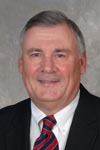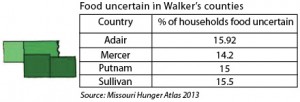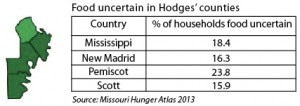Nate Walker, northern Missouri
Three out of four areas which Rep. Nate Walker, R-Kirksville, represents have been qualified as high-need and low-performance by the Missouri Hunger Atlas 2013. He said the issue of hunger in his district is one that must be “continually addressed.”

Walker said his hometown of Kirksville (in Adair County) recently held a public forum on homelessness to identify issues with the poor. In Adair and Sullivan counties, the population base below poverty level is at 20.5-31.8 percent of the population, according to the Missouri Hunger Atlas 2013. Putnam County’s below poverty level is 16.9-20.4 percent of the population and Mercer County is at 15.4-16.8 percent, according to the atlas. Walker shares representation of Adair County with Rep. Craig Redmon, R-Canton.
Local community support is one key to addressing hunger, Walker said. Churches and larger organizations like the United Way have donated to those in need.
“It’s a complex issues and every community has to work together so that we take care of people who can’t take care of themselves,” Walker said.

In addition to hunger and food issues, Walker said health care access needs to be tackled.
“We have to continue to make sure that we have rural doctors and rural medical care,” Walker said.
Walker said for his district, stronger farming means a stronger economy. Two drought years have hurt his district, he added. Last year, he said, farmers grew about 40 bushels per acre. This year he expects about 80. But in the inadequate years, farmers tallied 20 bushels an acre.
Adair County has a population percentage eligible for the SNAP program at 28-39.3 percent. Sullivan is at 24.9-27.9 percent and Putnam and Mercer Counties are at 21.2-24.8 percent.
“I think most people know how to get on the programs and access them,” Walker said. “It’s unfortunate we don’t have a good economic base where more people can work and live and have affordable salaries.”
[divider style=”tiny”][/divider]
Steve Hodges, Missouri’s boot heel

Living in Mississippi County for about 50 years, Rep. Steve Hodges, D-East Prairie, said he remembers when food stamp commodities were first shipped into the county. The comparison of the need between then and now has increasing changed from what Hodges has witnessed.
“[The need then] doesn’t hold a candle to what we have now,” Hodges said.
Hodges represents four counties in Missouri’s boot heel — one of the poorest areas in the state. In Scott County, 21.2-24.8 percent of the population is eligible for SNAP, according to the Missouri Hunger Atlas 2013. Hodges’ other three counties (Mississippi, New Madrid and Pemiscot) are all in the 28-39.3 population percentage eligible for the program, according to the atlas.

The children in Mississippi County, Hodges said, receive food from the school system through breakfast programs and Buddy Pack programs in which children’s backpacks are filled with food for the weekend. The percentage population of children in Scott County who are eligible for the National School Lunch Program, according to the atlas, is 11.5-40.8 percent of students K-12. In Pemiscot, the percentage is 58.1-65.9 percent and New Madrid and Mississippi counties children eligible is 66-73.7.
“If you came to my town and we got in the car and I took you around, and I’ve done this with government people who’ve come before, and I showed you where some of these people live,” Hodges said. “And I said that’s where these children go home at night and that’s where they spend their weekends. If it doesn’t change your attitude then you’ve got a pretty hard heart.”
Hodges said the high poverty rates in his district may be a result of the few amount of jobs that aren’t agriculturally related. He added that technology, like bigger machines and computers, have replaced farming jobs that people once performed.
Brittany Ruess was a reporter for The Missouri Times and the SEMO Times, and a graduate of Webster University.



